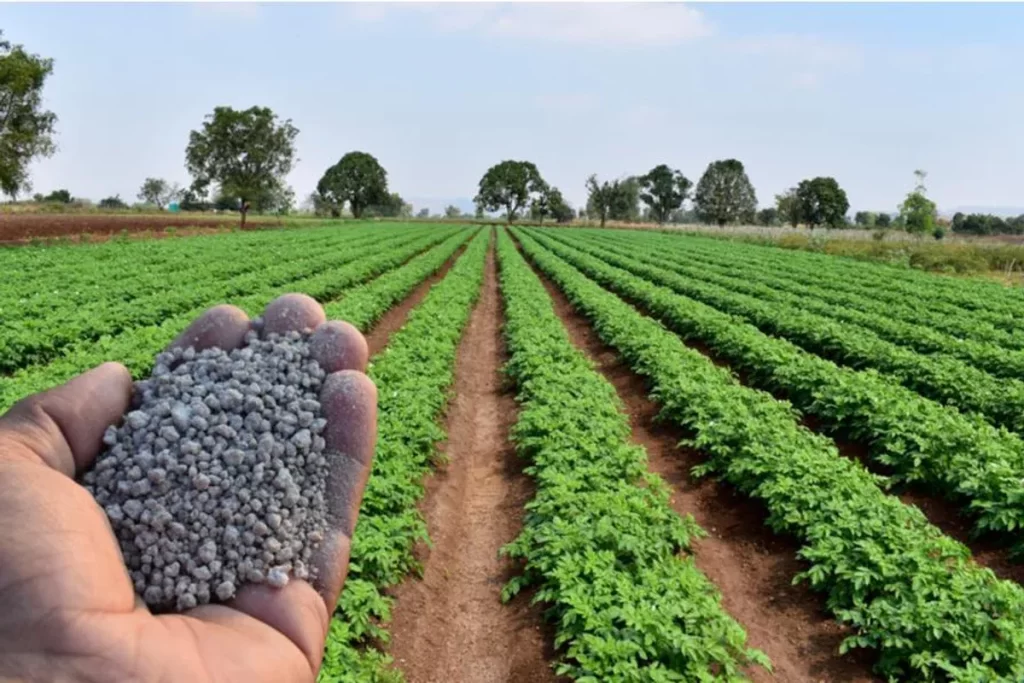Single Super Phosphate Benefits
Single super phosphate benefits are numerous and well-recognized in the agricultural industry. With the various benefits it holds in improving the fertility of the soil, SSP has been one of the most commonly used fertilizer types by farmers who wish to improve on the productivity of their crops. The Primary benefit of SSP is high phosphorous content with phospher content analysis of 16-20 percentages of phosphorus pentoxide (P2O5).

Phosphorus is an essential element that is needed by plants for root formation, energy transference and flower, fruit, and seed production. Being a rich source of phosphorus, SSP makes it possible for plant to grow to its optimal full-growth capability since phosphorus is an essential nutrient input for plants.
What are the advantages of single super phosphate?
Phosphorus Content: An attractive feature of single super phosphate to be highlighted is that its content of P2O5 is notably high. It is scheduled that single super phosphate has 16-20% phosphorus pentoxide (P2O5); thus it is good fertilizer to supply phospher for plant growth. Phosphorus is indispensable for growth of the root system, transmission of energy and formation of florescence, fruits and seeds. The farmers should ensure that they provide sufficient amount of phosphorus from the SSP fertilizer so that the plants grow vigorously and produce good yields.

Calcium and Sulfur Content: Single super phosphate also comprises of calcium and sulfur apart from phosphorus. Calcium is essential for the development of cell wall of plant cells, root system and rigidity of plant body. Sulfur however plays a critical role in chlorophyll synthesis, protein formation, the formation of enzyme and vitamin. The following nutrients present in single super phosphate affect the quality of the crops by enhancing their health and vigour.
Soil pH Regulation: Single super phosphate is a water soluble fertilizer and it has neutral pH hence can be used on any type of soils. Despite the fact that most other fertilizers which are containing potassium have effects on the changes of soil acidity or alkalinity, SSP fertilizer does not have such effects much. This characteristic makes it easy for farmers to use single super phosphate in their farming regardless of the pH levels hence making the process of fertilizing easy.
Improved Nutrient Availability: The single super phosphate formula ensures that the phosphorus is readily available to plants. The manufacturing process of SSP fertilizer involves treating rock phosphate with sulfuric acid, which converts the insoluble phosphate into a more soluble form. This solubility enhances the uptake of phosphorus by plant roots, enabling them to access and utilize the nutrient efficiently.
Cost-Effectiveness: Among all the phosphate fertilizers, single super phosphate is not very expensive. In terms of price, the single super phosphate 50 kg price is relatively low as compared to most of the specialized fertilizer brands. Because of its cost SSP fertilizer can be incorporated into plant nutrient management strategies without greatly affecting the farmer’s pocket.
What is super phosphate good for?
Single super phosphate is widely used for the crops which need large amount of phosphorus compounds. Some examples of crops that thrive with SSP fertilizer include:Some examples of crops that thrive with SSP fertilizer include:

Legumes: Low phosphorus is found in leguminous crops including beans peas and lentils these crops have a large demand for phosphorus. Single super phosphate offers the said phosphorus with bearing root development, nodule formation and nitrogen fixing in these crops.
Root Crops: Potato, carrot and turnip crops are those crops which need phosphorus in order to grow good roots system. SSP fertilizer enhances strong and healthy growth of roots in crops hence enhancing the quality and quantity of crops produced.
Fruits and Vegetables: Fruits and vegetables in particular respond very well to single super phosphate application. Phosphorus plays a crucial role of in flower initiation, fruiting, and in general the quality of the produce. Single super phosphate plays the role of ensuring that these crops are availed with phosphorus at all the stages of their development.
Cereals: It has been observed that crops like wheat, rice and maize which are categorized under cereal crops performs better with the help of SSP fertilizer. Phosphorus is important to tillering, grain formation and growth of a good root system in these crops.

Oilseeds: Among the crops, soybean, sunflower, and canola which are used as oilseed crops have relatively higher requirement for phosphorus. Single supper phosphate supplies adequate amount of phosphorus for seed formation, oil bearing quality and yield.
What are the benefits of SSP?
SSP fertilizer offers several benefits that make it a preferred choice among farmers:SSP fertilizer offers several benefits that make it a preferred choice among farmers:
Nutrient Balance: Single super phosphate has ability to proffer balanced amount of phosphorus, calcium and sulfur required for the plant growth. These nutrients interact with each other to make the plants grow healthy and increase fertility of the soil as well as enhancing crop production.

Slow-Release: Unlike other fertilizers which available nutrients rapidly in the soil, the nutrient available in the SSP fertilizer soil has a slow-release system. The phosphorus in single super phosphate operates in a slower time form, thus ensuring that plants nutrients requirement is availed to them as they grow. This slow-release property minimizes the loss of the nutrients to seepage and also helps the crop to effectively use the nutrients.
Improves Soil Structure: Single super phosphate contains an amount of calcium that enhances the structures of the soils. Calcium is used in soil compaction process to enhance availability of air, water and root penetration on soils. Loosening compacted soil structures makes it easy for plant roots to penetrate through the soils and at the same time making the soil healthy.
Compatibility with Other Fertilizers: Further, SSP fertilizer has the advantage of compatibility with other types of fertilizer hence its ease to be integrated with other nutrient management practices. Farmers can mix single super phosphate with nitrogen as well as potassium fertilizers to develop a rather complete nutrient program to suit their crops.

Drought Resilience: Phosphorus is particularly important when it comes to development of a good root system. Single super phosphate helps farmers in encouraging deep extensive root by which the plant has better absorption of water and nutrients in the deeper soil profile. This enhances the root areas and makes crops to be more resistant to drought stress thus maintaining stable yields of any crop in case of limited water availability.
What is the use of SSP?
Single super phosphate finds applications in various agricultural settings:Single super phosphate finds applications in various agricultural settings:

Basal Fertilizer: SSP fertilizer is wholly used in form basal fertilizer where it is applied to the field either during tillage operation or planting. Basal application provides a constant supply of the phosphorus needed by the plants as they get established in the earliest stage of development in particular the development of roots.
Top Dressing: Single super phosphate can also be used as a top dressing fertilizer typically applied at mid vegetative growth of crops. SSP fertilizer to top dress the seedlings gives an additional phosphorus to feed the plants’ continued development.
Fertigation: Single super phosphate can in fact be water soluble and it can be in a form that it can be applied under the system called fertigation. Fertigation makes it possible for the nutrient to be applied at the root zone, thus reducing wastage of nutrients.
Seed Treatment: SSP fertilizer can be applied to seed by the process of seed dressing,which aims at improving germination rates and initial seedling vigour. Coating seeds with single super phosphate avail source of phosphorus to the developing seedlings hence improving growth and establishment rates.
Soil Amendment: It can be applied, for instance, in the P-poor soils or those which produce high P-fixation. Holding a primary position in structural formations, the phosphorus in SSP fertilizer rebuilds the depleted phosphorus pool and enhances long-time yield per hectare capability of the soil.
What are the benefits of SSP therapy?
SSP therapy, or Sensory Integration-Based Occupational Therapy, is a different concept from single super phosphate fertilizer. SSP therapy is used in treating SPS or Sensory Processing Disorder, which alongside other disorders like autism or ADHD, affects one’s capability to process sensory information well. Although the almost similar acronym “SSP” the facilities and utility of the SSP therapy has no connection with singled super phosphate in agriculture.

What is an SSP used for?
According to the South African context, single super phosphate is an essential fertilizer applied to agricultural land for supplying crops with phosphorus nutrition. SSP fertilizer is used in the soil to make the soil more fertile and to enable plants to grow well and increase yield. It is used for many crops, for example, the legume, root crops, fruits, vegetables, cereals, and oilseeds crops among them.
Single super phosphate 50 kg price
The price of single super phosphate can vary depending on the region, market conditions, and supplier. On average, the single super phosphate 50 kg price ranges from INR 500 to INR 2000 (approximately USD 6 to USD 20) in India. Nonetheless, it is advised that the actual market prices vary and one has to contact nearby suppliers or the dealers in agricultural inputs to get the accurate prices.
Single super phosphate formula
The single super phosphate formula is represented as Ca(H2PO4)2·H2O + CaSO4·2H2O. This formula also shows that single super phosphate has monocalcium phosphate monohydrate and calcium sulfate dihydrate as constituents. The production process of making this is by reacting rock phosphate with sulfuric acid to achieve this specific chemical formula.
Single super phosphate content
Single super phosphate typically contains the following nutrient content:Single super phosphate typically contains the following nutrient content:
- 16-20% phosphorus pentoxide (P2O5)
- 12-14% calcium (Ca)
- 10-12% sulfur (S)
This makes it hard to quantify all the ingredients in the final product to the last detail, especially owing to differences in the manufacturing process as well as the quality of the raw materials that was used.
Single super phosphate contains
Single super phosphate contains three main nutrients: Of the three, phosphorus, calcium and sulfur stood out as needing attention in the out years. The phosphorus content is in the form of monocalcium phosphate, which is in plant available form in the soil sol solutions. The calcium and sulfur are present as calcium sulfate, providing additional Single super phosphate benefits to plant growth and soil health.
Single super phosphate composition
The SSP fertilizer composition includes:
- Monocalcium phosphate monohydrate: Ca(H2PO4)2·H2O
- Calcium sulfate dihydrate: CaSO4·2H2O
- Trace amounts of other nutrients and impurities
The specific composition may vary slightly based on the manufacturing process and the purity of the raw materials used.

Single super phosphate in hindi
In Hindi, single super phosphate is known as “एकल सुपर फॉस्फेट” (Ekal Super Phosphate). It is applied and famous fertilizer in India this fertilizer has phosphorus which helps in improving the cropping cycle.
Single super phosphate percentage
The percentage of nutrients in single super phosphate is as follows:
- Phosphorus pentoxide (P2O5): 16-20%
- Calcium (Ca): 12-14%
- Sulfur (S): 10-12%
These percentages represent the typical nutrient composition of SSP fertilizer, although slight variations may occur depending on the manufacturing process and quality control measures.
Diammonium phosphate
Diammonium phosphate (DAP) is a widely used phosphatic fertilizer known for its high nutrient content. While single super phosphate is concerned it contains phosphorus alone but DAP, apart from phosphorus contains nitrogen as well which is 18%.
This two nutrient content also make DAP to be most preferred by farmers who want to give crops a boost of essential nutrients in one go. The portion of nitrogen in DAP enhances growth of foliage while phosphorus element aids in the development of root, flowering as well as fruiting.
Another strength with DAP is the fact that it has a very high analysis that is a lot of nutrients in the fertilizer as opposed to other types of fertilizers like the single super phosphate. They include increased nutrient concentration which makes farmers use lesser fertilizer on the same area of land hence cutting on transport and application cost.
However, it’s important to note that while DAP offers a potent nutrient punch, it lacks the additional Single super phosphate benefits of calcium and sulfur found in SSP fertilizer. The absence of these secondary nutrients may require supplementation from other sources to ensure balanced plant nutrition and optimal crop growth.
Single fertilizer example
Single super phosphate is a good example of single fertilizer since it is meant to supply one nutrient; phosphorus to the plant. There are what are termed as single fertilizers which are products that have been prepared to meet certain nutrient deficiencies on the soil or to meet the needs of certain crops. These fertilizers offer a precision of nutrient distributions, and growers are capable of adjusting it based on the results of the tests done on the soil as well as the nutrients required by the crops.
Other examples of single fertilizers include urea, which is a nitrogen-rich fertilizer containing 46% nitrogen, and muriate of potash, which supplies potassium to plants. Ammonium sulfate is another single fertilizer which contains both nitrogen and sulfur Speaking of sulfur, there are single fertilizer sulfur, containing both nitrogen and sulfur. All these fertilizers play a certain role in agriculture by supplying the nitrogen that contributes to green growth, the potassium that contributes to disease control and fruits quality and sulfur that can improve plant vigour and stress tolerance. However, in realizing how each single fertilizer functions and the requirements of the farmers’ crops and their soils, then the farmers will be in a position to apply the nutrient sources in an effective manner.
Single super phosphate is a valuable fertilizer that offers a range of Single super phosphate benefits for agricultural practices. It has high phosphoric acid content and also contains calcium and sulfur that are very beneficial in boosting plant growth, increasing fertility of the soils and increasing crop productivity. A major drawback of single super phosphate is that it slowly releases nutrients to the crops nevertheless, single super phosphate has several significant benefits, which makes it a product that is highly sought by farmers around the globe.
By understanding the composition, uses, and Single super phosphate benefits, farmers can make informed decisions about integrating it into their nutrient management strategies. It is used as a basal fertilizer, a top dressing or incorporated in the root zone either through the drip or the sprinkle irrigation – single super phosphate brings a social change to the cultivation of crop plants and practice of sustainable agriculture.
In the application of any fertilizer, right practices must always be followed, soil samples should always be taken and contact with the local agricultural extension agencies should always be made for them to recommend to their farmers’ use rates and timing that best suit a certain crop and the type of soil it grows on. With single super phosphate as a tool, farmers shall be in a position to maximize on their yields through remarkable performance in their farming activities.
